
 |
||||
| INDEX | next
|
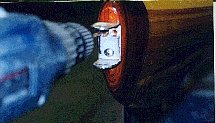 |
A
stainless square
bracket is mounted after varnishing. The kayak is level transversally and the entire rudder assembly is positioned so that the rudder is 1) plumb and 2) has the desired range of motion. The bracket must be held in this position without movement to achieve good accuracy of the screw holes. The drill holes are sealed with varnish thereafter. Use toothpicks or matches. |
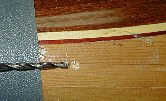 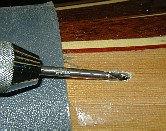
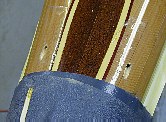
|
Holes
for the rudder cable guides are snug so that the cable housing doesn't slide out. I usually add
a bit of silicone sealant to the underside to assure watertight seal. The spot is first masked with a clear tape and then drilled with a brad point drill at an acute angle. The hole is sealed with epoxy and the cable guide is threaded through immediately thereafter. |
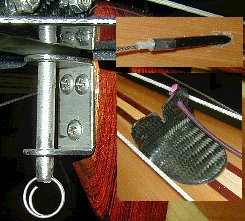 |
Click
on to see the full size details. The rudder blade retainer bracket is bonded
with silicone so that it can be removed for varnishing if needed. The purple
cord is a thin bungee to hold the blade during transport. Note how the Teflon insert in the cable guide protrudes from the termination cap. A drop of silicone inside the cap protects the metal coil inside the guide from salt water. For a composite alternative to the stainless bracket, check out the Rudder Construction Intro. (Builders of the Carbon Rudder will find the complete bracket building procedure illustrated step by step in the on-line rudder manual.) |
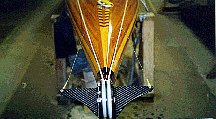 |
To
assure smooth rudder control, the cable guides are run as straight as practical.
The cable is a made of strong, corrosion resistant Stainless steel . Low
friction cable guides carry the cable inside the kayak bulkheads and through
the deck. This ensures watertight seal. See also the connection between the rudder and sliding footbraces Making cable end loops |
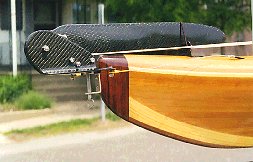 |
The
rudder blade is made of s-glass, 1/16"plywood core and carbon fabric.
The whole system weighs under a pound and works flawlessly. The stiff blade
is not quite a NACA 0015 section shape but is more effective than flimsy
plate of aluminum. The range of motion is ~35°. Bigger angles result in flow separation and stalling. Plans , Kits and footbraces for this rudder are now available. |
| INDEX |
| Home | Kayak Designs | Kayak Shop | Materials | Kayak Gallery | About us |
| Building Manual | Plans | Sandwich Core | Wood Kayak | Order | |
| Epoxy Test | Abrasion Cloth | Rudder | Resources | Choosing Kayak | Guestbook |
If you notice any problems with the site (i.e. error links, missing images) please, let me know. Thanks
Mail:
Vaclav Stejskal
10 Colonial Court apt. 73
Stoneham, MA. 02180
USA
Tel: 781-481-9261
© 1999
- 2020 Copyright Vaclav Stejskal
All rights reserved
Last page update:
11 January 2020